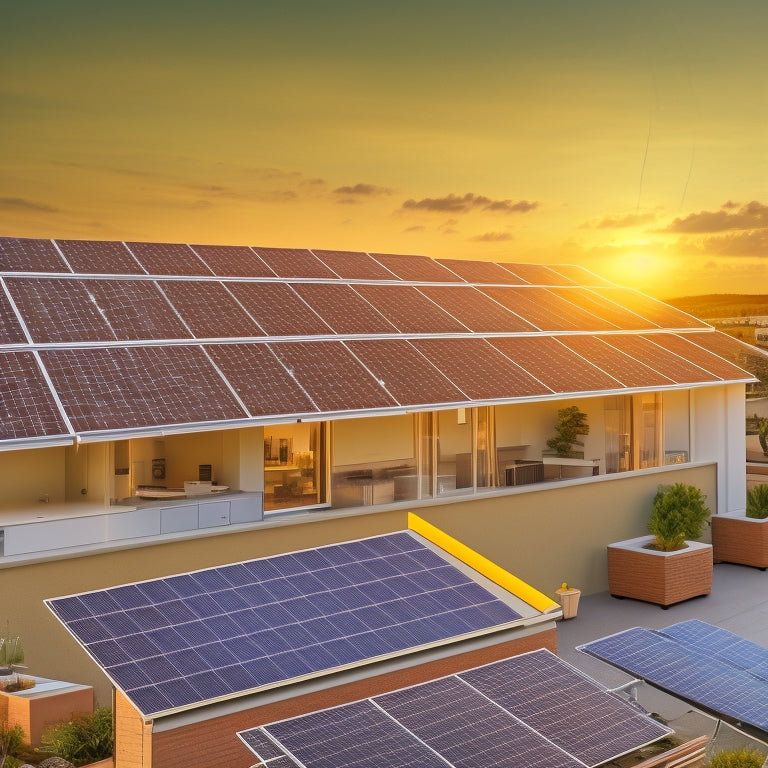
7 Best Ways to Monitor Solar Panel Performance
Share
You can optimize your solar panel performance by utilizing seven key monitoring methods. Start with real-time monitoring systems that provide instant insights, then leverage mobile apps for performance tracking. Inverter monitoring and alerts can identify issues promptly. Energy output analytics tools help optimize production, while environmental impact assessments and performance benchmarking standards guarantee your system operates efficiently. Finally, remote system inspection tools streamline maintenance. By combining these methods, you'll be able to identify issues quickly, reduce downtime, and increase energy output. To reveal the full potential of your solar panel system, explore these methods in more detail.
Key Takeaways
• Implement real-time monitoring systems to track energy output, temperature, and voltage, enabling swift issue identification and troubleshooting.
• Utilize mobile apps for performance tracking, receiving alerts, and accessing real-time data to optimize energy production.
• Leverage inverter monitoring and alerts to detect potential issues, reducing downtime and enhancing overall system performance.
• Employ energy output analytics tools to identify optimization opportunities, benchmark performance, and assess environmental impact.
• Integrate virtual tours, augmented reality, and automated reporting to streamline monitoring, inspection, and maintenance processes.
Real-time Monitoring Systems
Real-time monitoring systems empower you to track your solar panel's performance instantly, providing valuable insights into its energy production and potential issues. With real-time monitoring, you can identify underperforming panels, diagnose issues, and optimize energy output.
This is made possible through advanced data analytics, which process data from sensors and inverters to provide actionable insights. System integration plays an essential role in real-time monitoring, as it enables seamless communication between different components of your solar panel system.
By integrating data from various sources, you can gain a thorough understanding of your system's performance and make data-driven decisions. For instance, you can track energy production, voltage, and temperature in real-time, enabling you to detect anomalies and take corrective action.
Real-time monitoring systems provide you with the power to maximize your solar panel's performance, reduce downtime, and increase energy yields. By leveraging the power of data analytics and system integration, you can realize the full potential of your solar panel system.
Mobile App Performance Tracking
With a mobile app, you can conveniently track your solar panel's performance on-the-go, receiving instant notifications and updates on your system's energy production, voltage, and temperature. This allows you to monitor your system's performance remotely, making it easier to identify and address any issues promptly.
A well-designed mobile app should provide an essential user experience, making it easy for you to navigate and access the information you need. Data visualization plays a vital role in this, as it enables you to quickly understand complex data and make informed decisions.
For instance, you can view graphical representations of your energy production, comparing it to previous periods or industry benchmarks. This data-driven approach empowers you to optimize your solar panel's performance, maximizing your energy output and reducing costs.
Inverter Monitoring and Alerts
Your inverter, the brain of your solar panel system, relies on precise monitoring to guarantee peak energy conversion, and you can achieve this by setting up inverter monitoring and alerts. This essential step ensures your system operates at its best levels, detecting even the slightest deviations from normal functioning.
Inverter monitoring enables real-time tracking of performance metrics, such as voltage, current, and power output. By doing so, you can identify potential issues before they escalate into major problems, ensuring uninterrupted energy generation.
Fault detection is an important aspect of inverter monitoring, allowing you to pinpoint and address issues promptly. This proactive approach prevents system downtime, reducing the likelihood of energy losses and revenue losses.
Additionally, inverter monitoring facilitates seamless grid synchronization, ensuring your system operates in harmony with the grid. With inverter monitoring and alerts, you can rest assured that your solar panel system is running at its best, providing you with the power you need to stay energized.
Energy Output Analytics Tools
By analyzing your energy output data, you can uncover hidden patterns and trends that inform peak system performance, and energy output analytics tools provide the insights you need to do just that. These tools help you make sense of the vast amounts of data generated by your solar panel system, identifying areas of improvement and opportunities for optimization.
With advanced data visualization capabilities, you can quickly identify trends and anomalies in your energy output, allowing you to take corrective action to maximize your system's performance. Predictive modeling capabilities also enable you to forecast energy output and adjust your system's configuration accordingly. This guarantees that your system is always running at peak efficiency, maximizing your energy output and reducing downtime.
Environmental Impact Assessment
When evaluating the environmental impact of your solar panel system, you'll want to take into account two key aspects: air quality monitoring and energy consumption tracking.
By monitoring air quality, you'll be able to quantify the positive impact of your solar panels on reducing air pollutants.
Meanwhile, tracking energy consumption will help you understand how much energy your system is producing and how it's reducing your reliance on non-renewable energy sources.
Air Quality Monitoring
You can evaluate the environmental impact of your solar panel system by monitoring air quality, which is critical in assessing the effectiveness of renewable energy sources in reducing greenhouse gas emissions. By tracking air quality, you can quantify the positive impact of your solar panels on the environment. This is particularly important, as air pollution is a significant concern for both human health and the environment.
Here are some key aspects to assess when monitoring air quality:
-
Particulate analysis: Measure the concentration of particulate matter (PM) in the air, which is a key indicator of air quality.
-
Atmospheric modeling: Use computer models to simulate atmospheric conditions and predict air quality.
-
Air quality indexes: Track air quality indexes, such as the Air Quality Index (AQI), to quantify the level of air pollution.
-
Emission reduction: Monitor the reduction of emissions from fossil fuels, which is a direct result of using solar energy.
-
Comparison to baselines: Compare your air quality data to established baselines to evaluate the effectiveness of your solar panel system.
Energy Consumption Tracking
Your solar panel system's energy consumption tracking provides a detailed picture of its environmental impact by quantifying the amount of fossil fuel energy it displaces. This information is essential in understanding the system's effectiveness in reducing your reliance on non-renewable energy sources.
By monitoring energy consumption, you can identify areas of inefficiency and optimize your system's performance. You can track your energy consumption patterns over different billing cycles to pinpoint opportunities for improvement.
Appliance auditing, for instance, can help you identify which appliances are consuming the most energy and make informed decisions about replacement or upgrade.
With accurate energy consumption tracking, you can refine your energy management strategy, reduce your carbon footprint, and maximize the benefits of your solar panel system.
Performance Benchmarking Standards
Setting performance benchmarking standards for solar panels guarantees that manufacturers and installers can accurately compare and rate their systems against industry-recognized metrics. This ensures that solar panels meet global compliance requirements, ensuring peak performance and efficiency.
To achieve this, you can follow these industry standards:
-
IEC 61724: Specifies the requirements for the performance monitoring and assessment of photovoltaic (PV) systems.
-
UL 1741: Covers the standard for safety of inverters, converters, and controllers for use in independent power systems.
-
IEC 61215: Defines the requirements for the design qualification and type approval of terrestrial photovoltaic modules.
-
ASTM E903: Provides the standard test method for determining the performance of photovoltaic modules and systems.
-
IEC 62446: Specifies the requirements for the grid connection of PV systems.
Remote System Inspection Tools
Remote system inspection tools enable real-time monitoring and analysis of solar panel performance, allowing for swift identification and troubleshooting of potential issues. As a solar panel operator, you can leverage these tools to optimize energy output and reduce downtime. With remote inspection tools, you can access your solar panel system from anywhere, at any time, and receive real-time data on performance metrics such as energy production, temperature, and voltage.
| Feature | Benefit |
| Virtual Tours | Visual inspection of the solar panel system without physical presence |
| Augmented Reality | Interactive 3D models for immersive system analysis |
| Real-time Data | Instant access to performance metrics for swift issue identification |
| Automated Reporting | Scheduled reports for streamlined performance tracking |
Frequently Asked Questions
Can I Monitor My Solar Panel Performance From a Single Dashboard?
"You can consolidate your solar panel data in a single dashboard, enabling centralized tracking and real-time analytics, providing instant insights into performance, efficiency, and potential issues, allowing you to optimize energy harvesting and maximize returns."
How Often Should I Clean My Solar Panels for Optimal Performance?
'Like a Renaissance artisan polishing a masterpiece, you'll want to clean your solar panels quarterly to prevent dust accumulation, ensuring peak energy harnessing; diligent panel maintenance is key to maximizing your renewable returns.'
Do I Need a Wi-Fi Connection for Real-Time Monitoring Systems?
You'll need a reliable internet connection, typically via Wireless Routers, to enable real-time monitoring systems, which transmit data to your devices, but some systems can store data locally for later upload, minimizing internet connectivity requirements.
Can I Integrate My Solar Panel System With My Smart Home Devices?
You can integrate your solar panel system with your smart home devices, enabling smart integration and voice control, allowing you to monitor and control your energy usage seamlessly, and optimize your energy efficiency with ease.
Are There Any Certifications Required for Solar Panel Installers?
As you venture into the solar domain, you'll need to make sure your installer is certified to shine. In the US, they must meet license requirements and training standards, like NABCEP certification, to guarantee a high-quality installation that harnesses the sun's full potential.
Related Posts
-

Why Choose Affordable Electric Scooters for Urban Commuting
By choosing an affordable electric scooter for urban commuting, you'll not only reduce your transportation costs by u...
-

What's the Best Green Ride for College Budgets?
As a college student on a budget, you're likely looking for an eco-friendly ride that won't break the bank. You've go...
-

Boosting Motorcycle Performance With High-Torque Upgrades
You're seeking to maximize your motorcycle's full potential with high-torque upgrades. By swapping to a high-torque m...


